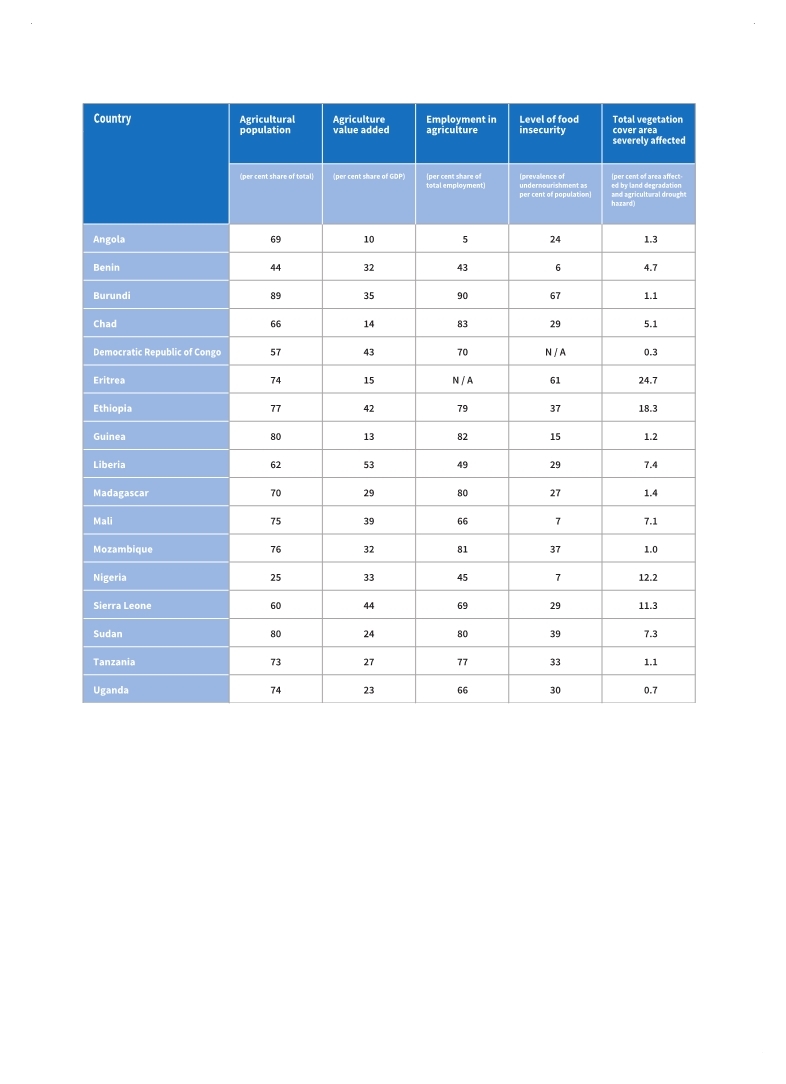 |
Global Assessment Report on Disaster Risk Reduction 2015
Making development sustainable: The future of disaster risk management |
 |
Global Assessment Report on Disaster Risk Reduction 2015
Making development sustainable: The future of disaster risk management |
|
|

84
Part I - Chapter 3
Table 3.2 Agriculture, land degradation and drought in sub-Saharan Africa
(Source: UNISDR with data from FAO, 2014
FAO (Food and Agriculture Organization). 2014,The State of Food and Agriculture: Innovation in family farming, Rome.. .  Erian et al., 2014 Erian et al., 2014 Erian, Wadid, Bassem Katlan, Naji Assad and Sanaa Ibrahim. 2014,Effects of Drought and Land Degradation on Crop Losses in Africa and the Arab Region with Special Case Study on: drought and conflict in Syria, Background Paper prepared for the 2015 Global Assessment Report on Disaster Risk Reduction. Geneva, Switzerland: UNISDR.. Erian, Wadid, Bassem Katlan, Naji Assad and Sanaa Ibrahim. 2014,Effects of Drought and Land Degradation on Crop Losses in Africa and the Arab Region with Special Case Study on: drought and conflict in Syria, Background Paper prepared for the 2015 Global Assessment Report on Disaster Risk Reduction. Geneva, Switzerland: UNISDR.. Click here to view this GAR paper. Note: Where data is not included in the table, it is because no data was readily available.
of GDP, and the probable maximum loss (PML) from a 1-in-25-year drought is equal to 10 per cent of GDP. In addition, a 1-in-25-year drought would exacerbate income poverty by 17 per cent, which would mean an additional 2.1 million people falling below the poverty line (World Bank et al., no date).
The picture is equally critical in West Africa. Mali, for example, faces a 10 per cent probability of suffering production losses amounting to US$48
million or larger in 50 years for millet alone (Figure 3.34). In Senegal, millet production losses for the same return period are US$15 million or more.
According to the IPCC, “climate change is very likely to have an overall negative effect on yields of major cereal crops across Africa, with strong regional variability in the degree of yield reduction” (IPCC, 2014
IPCC (Intergovernmental Panel on Climate Change). 2014,Climate Change 2014: Impacts, Adaptation, and Vulnerability, Working Group II. Cambridge and New York: Cambridge University Press.. . |
 
Page 1Page 10Page 20Page 30Page 40Page 50Page 60Page 70Page 74Page 75Page 76Page 77Page 78Page 79Page 80Page 81Page 82Page 83Page 84Page 85->Page 86Page 87Page 88Page 89Page 90Page 91Page 92Page 93Page 94Page 95Page 96Page 97Page 98Page 100Page 110Page 120Page 130Page 140Page 150Page 160Page 170Page 180Page 190Page 200Page 210Page 220Page 230Page 240Page 250Page 260Page 270Page 280Page 290Page 300Page 310
|
|
 
|
 
|
